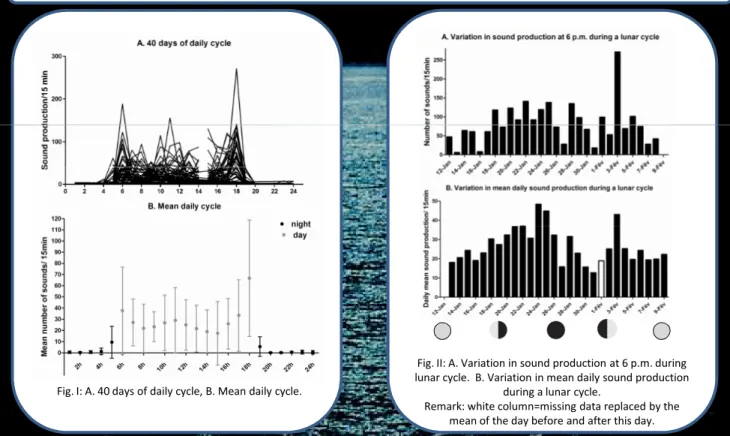Variations of sound production in Dascyllus flavicaudus
Damselfishes (Pomacentridae) are prolific callers which emit sounds in different behaviors. In theyellowtail damselfish Dascyllus flavicaudus, six behaviors are known to be related to six types of sounds. Generally speaking, these sounds are mainly involved in courtship (signal jump and visiting-mating) and agonistic behaviors (hetero- and conspecific fighting, and hetero- and conspecific chasing). However, temporal variability of sound production has never been explored in this species. In this context, the present study aimed to identify the periods of acoustic activity in this species.
Recordings of sound production by Dascyllus flavicaudus were made from January to March 2009 in Moorea lagoon (French Polynesia). Hydrophone was associated to an IT program allowing the searchers to plane the recording time slot and is used to study periodicity of sound production. A recording slot of 15 min each hour are chosen to describe the daily and lunar variations.
Dascyllus flavicaudus produces sounds mostly during the day and shows the highest rate of production at dusk (Fig. I). On the basis of the six behaviors associated to sound production in this species, this peak was associated to reproduction.
Introduction
Material and methods
Results and discussion
Moreover, sound production activity increases during the periods between last quarter and new moon, and around first moon quarter (Fig. II). Full moon phases show the lowest rate of sound production (Fig. II). These peaks of activity during the month seem in relation with adequate period of egg release and reef settlement of the larvae, both behaviors being safer during dark nights.
Sound production shows great variations within a day and the peak observed at dusk is linked to reproduction. During the lunar cycle, sound production vary more randomly even if it seems to increase around the moon quarters. A long-term study would give more information about the lunar cycle and also about seasonality in sound production.
Conclusion
Fig. I: A. 40 days of daily cycle, B. Mean daily cycle.
Fig. II: A. Variation in sound production at 6 p.m. during lunar cycle. B. Variation in mean daily sound production
during a lunar cycle.
Remark: white column=missing data replaced by the mean of the day before and after this day.
Variations of sound production in Dascyllus flavicaudus
Damselfishes (Pomacentridae) are prolific callers which emit sounds in different behaviors. In the yellowtail damselfish Dascyllus flavicaudus, six behaviors are known to be related to six types of sounds. Generally speaking, these sounds are mainly involved in courtship (signal jump and visiting-mating) and agonistic behaviors (hetero- and conspecific fighting, and hetero- and conspecific chasing). However, temporal variability of sound production has never been explored in this species. In this context, the present study aimed to identify the periods of acoustic activity in this species.
Recordings of sound production by Dascyllus flavicaudus were made from January to March 2009 in Moorea lagoon (French Polynesia). Hydrophone was associated to an IT program allowing the searchers to plane the recording time slot and is used to study periodicity of sound production. A recording slot of 15 min each hour was chosen to describe the daily and lunar variations.
Dascyllus flavicaudus produces sounds mostly during the day and shows the highest rate of production at dusk (Fig. I). On the basis of the six behaviors associated to sound production in this species, this peak was associated with the reproduction.
Introduction
Material and methods
Results and discussion
Moreover, sound production activity increases during the periods between last quarter and new moon, and around first moon quarter. Full moon phases show the lowest rates of sound production. These peaks of activity during the month seem in relationwith adequate period of egg release and reef settlement of the larvae, both behaviors being safer during dark nights.
Sound production shows great variations within a day and the peak observed at dusk is linked to reproduction. During the lunar cycle, sound production vary more randomly even if it seems to increase around the moon quarters. A long-term study would give more information about the lunar cycle and also about seasonality in sound production.
Variations of sound production in Dascyllus flavicaudus
Damselfishes (Pomacentridae) are prolific callers which emit sounds in different behaviors. In the yellowtail damselfish Dascyllus flavicaudus, six behaviors are known to be related to six types of sounds. Generally speaking, these sounds are mainly involved in courtship (signal jump and visiting-mating) and agonistic behaviors (hetero- and conspecific fighting, and hetero- and conspecific chasing). However, temporal variability of sound production has never been explored in this species. In this context, the present study aimed to identify the periods of acoustic activity in this species.
Recordings of sound production by Dascyllus flavicaudus were made from January to March 2009 in Moorea lagoon (French Polynesia). Hydrophone was associated to an IT program allowing the searchers to plane the recording time slot and is used to study periodicity of sound production. A recording slot of 15 min each hour was chosen to describe the daily and lunar variations.
Dascyllus flavicaudus produces sounds mostly during the day and shows the highest rate of production at dusk (Fig. I). On the basis of the six behaviors associated to sound production in this species, this peak was associated with the reproduction.
Introduction
Material and methods
Results and discussion
Moreover, sound production activity increases during the periods between last quarter and new moon, and around first moon quarter. Full moon phases show the lowest rates of sound production. These peaks of activity during the month seem in relationwith adequate period of egg release and reef settlement of the larvae, both behaviors being safer during dark nights.
Sound production shows great variations within a day and the peak observed at dusk is linked to reproduction. During the lunar cycle, sound production vary more randomly even if it seems to increase around the moon quarters. A long-term study would give more information about the lunar cycle and also about seasonality in sound production.
